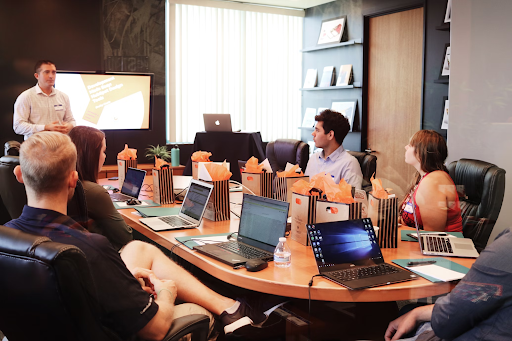
Ensure that training is a part of work with eLearning
Picture this, if you will.
The 'good' old days, when staff training was delivered in bland and soulless conference suites, with less than perfect coffee and an over reliance on flip charts. The days when employee engagement in their own professional development revolved more around the biscuit selection of a particular venue, or the time of the buffet, than anything else. The learning day had an agenda and crucially, a timetable. At the bottom of the day's timetable, was the word that learners engaged with the most. FINISH. Excited but hushed discussions would break out across the room, as people wondered whether the finish time would actually be at the time predicted, or whether they might get to leave a little early. Elbows would be nudged, comments whispered under breath “don’t ask any questions, they'll keep us here all day”.The next day, our intrepid learners would return to work, with valuable feedback for managers and colleagues on the important issues they discussed at the training day. “Well, the coffee was awful, and I didn't like the look of the buffet much, so only had a couple of sandwiches, but they had Hob-Nobs, and we were out of there by 4 o'clock, so it wasn't too bad, I suppose” At that point, all engagement was lost, as was much of the training budget.
Such was the culture of the times, a culture often encouraged by the poor quality of the training provided. For many, and all too often, training and learning in work was something to be endured rather than enjoyed.
That was very much then, and this is absolutely now. The model above, outdated and irrelevant as it is, is thankfully becoming a thing of the past, and with increasing momentum. Organisations and companies now recognise the need for a better return on investment, to enhance bottom-line impact through behavioural change. A change in corporate training demographics and the ongoing development of new technologies have thankfully cast the old model to the history books, in favour of faster, better, more fully engaged, and more cost effective methods of knowledge provision. Gone is the concept of 'post-training', the follow-through period where ideas reach implementation once the training has been completed. In fact, gone is the concept of the training being completed in the first place. New innovations, via e-learning, provide the opportunity for training to be ongoing and consistent, giving a much more reactive final result. Learning is no longer an environment for employees to step in and out of as and when management decide it to be appropriate. On the contrary, learning is full time, the workplace is the classroom, and the opportunity for personal and professional development becomes the lesson.
For any development programme to produce consistently positive and beneficial results, learners must be able to transfer and apply what they learn to their role in the organisation. Equally, the consistency demanded by modern learning practices, by its very nature providing data analysis, enables corporations to bring about change on a 'live' basis. Effective and constant monitoring can provide a host of benefits to organisations by enhancing the level at which learning is applied to the learner's role, and reiterating the importance of keeping the learning fresh and vital. In this way, both managers and learners act as facilitator.
Using e-learning technologies and methods cross-departmentally and simultaneously, strengthens employee to employee bonds by creating a learning support network, fuelled by the desire to learn, and the value they place on the learning. Users are more likely and willing to remain engaged with the goals they set for themselves and each other, and not just on the buffet or the biscuits! By establishing and maintaining these peer supported networks, and the processes involved in doing so, we see enhanced learning, successful learning transfer providing better results, and consequentially, an improved return on investment.
So, by changing the training, organisations are better placed to train for change, with users more enabled to incorporate the knowledge into their work, producing better end results. That word FINISH is at the bottom of the page no more, by utilising e-learning, there simply isn't a finish.


